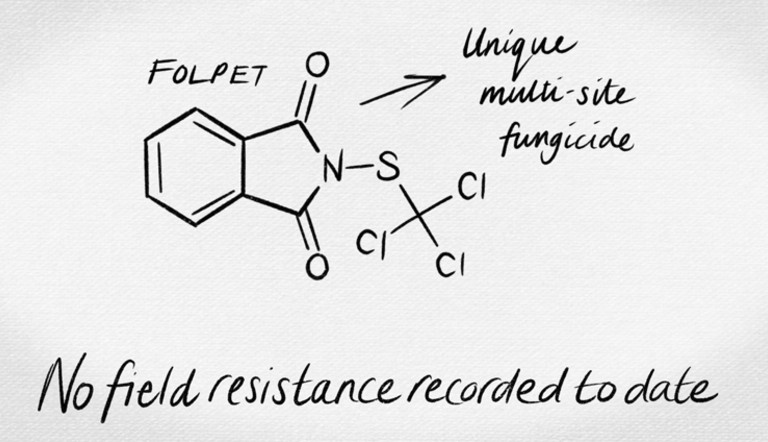
Phoenix® Fungicide steps up against Ramularia

For barley growers, and the industry, the most surprising thing about the uncompromisingly thorough defeat of SDHIs by Ramularia was how suddenly it happened. The implications of that for ongoing crop security and the protection of existing and emerging chemistry won’t have been lost on anybody.
Crop protection company ADAMA NZ, a long-time advocate of adding multi-sites to control Ramularia in barley and Septoria in wheat, described the collapse as “dramatic”. It was barley that was impacted this time, but ADAMA NZ also say continuing vigilance in wheat is vital. In the UK, often a bellwether for this country, triazoles are currently only giving around 35-40% Septoria control in wheat, down from 80-90%.
While multi-site protectant fungicide Phoenix, has provided a very effective addition to the Ramularia control toolbox, the failure of SDHI fungicides was a sobering reminder of how rapidly a crop that looks very promising can be stripped of its value.
Single-site chemistry breaking
The issue of resistance set alarm bells ringing in the UK more than a decade ago. Global fungicide expert and ADAMA UK Technical Specialist Andy Bailey was invited to visit New Zealand, in 2017 and 2018, to share the Northern Hemisphere’s experience with Ramularia and Septoria resistance. Andy described Ramularia as a “massive disease” and said the single-site chemistries previously used to control it were “breaking”.
He made a very strong argument for multi-sites, such as Phoenix. “They should be the first thing in the tank.” It is a recommendation that stands.
At the time Andy said that rather than something having gone particularly wrong to create the resistance, it is simply the almost inescapable outcome of the interaction between fungicides and disease. “Ultimately, if you’re using single-site acting fungicides, resistance will develop and it develops over a period of time depending on things including disease pressure, and how many times the fungicides are sprayed.”
“We still have a lot of really good tools at our disposal, which we can and should use. It’s all about carefully planned chemistry programmes.”
SDHI fungicides collapse
For New Zealand reality bit shortly after. A “perfect storm” of a wet 2018 barley growing season and the resulting high disease pressure fed Ramularia’s aggressive ability to mutate. The outcome was yield losses of up to 30%.
It took just three seasons, and the totality of the resistance is borne out by hard science.
According to FAR’s Autumn Round Up 2020, Plant & Food Research had identified three SdhC mutations that impacted on the performance of SDHIs against Ramularia in barley. In 2019, microplate assays found that 100% of the Ramularia isolates collected in the 2018-19 season were insensitive to this chemistry.
The failure of SDHIs against Ramularia saw growers rapidly re-assess programmes. As a result, ADAMA NZ’s multi-site Phoenix became a key part of disease control. Approved for Ramularia in time for the 2019 season Phoenix carried a weight of expectation, but was already proven in the UK and Europe, and in New Zealand against Septoria in wheat.
There is currently no recorded resistance to Phoenix’s active, folpet, anywhere in the world, and ADAMA’s testing has confirmed no sensitivity shifts against Septoria.
The FAR Crop Action Edition 134, 14 September 2018 reported that adding Phoenix to triazole Proline® in a two-spray programme gave significantly better control of Ramularia than mixes of triazole with SDHI and, also, the highest yield. That finding was reinforced in FAR’s virtual Autumn 2020 Round Up, which too reported good control from Phoenix mixed with Proline.
Andy said while Ramularia is still imperfectly understood, Phoenix is tested and proven. The chemistry works at a cellular level using a multi-site action; inhibiting spore germination and cell division and reducing energy production in the mitochondria. Phoenix does not inhibit DMI uptake, ensuring full availability and speed of activity of the applied dose.
ADAMA NZ recommends using Phoenix with all-rounder fungicide Bolide® or other triazole chemistry. Bolide is taken up via the stem and foliage and translocated upwards and outwards, providing some protection for new growth.
New Zealand trials with Bolide have not only shown outstanding control for a wide range of diseases comparable to industry standard SDHIs and DMIs, but also highly effective Ramularia control. This performance is strengthened even more when Bolide is tank-mixed with Phoenix.
Application timing is key
Ramularia’s invisibility early in the season and its devastating consequences mean it is always safest to presume it is already in the crop. If only one spray of Phoenix is being applied in barley, then T2 is the optimum timing for it. This ensures that leaves 2 and 3 are protected. For best results though, a programmed approach suggests even higher levels of Ramularia control when using Phoenix at both T1 and at T2. These applications maximise the crop’s green leaf area index to maximise yields by promoting healthy spikelet and ear development.
While recent drier seasons may have reduced some Septoria pressure in wheat, there is still a risk to yields, particularly in the high-value and more susceptible varieties. ADAMA NZ says their advice, as for barley, is to ensure Phoenix is first in the tank. Application at T1, with a DMI such as Bolide is strongly recommended and supported by industry bodies.
ADAMA NZ says protecting existing chemistry is not only an imperative for the cereal industry as a whole, but also for individual growers, with multi-site fungicides having an essential part to play.
